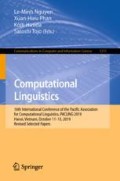Abstract
Recently, the data-driven machine learning approaches have shown their successes on many text classification tasks for a resource-abundant language. However, there are still many languages that lack of sufficient enough labeled data for carrying out the same specific tasks. They may be costly to obtain high-quality parallel corpus or cannot rely on automated machine translation due to unreliable or unavailable machine translation tools in those low-resource languages. In this work, we propose an effective transfer learning method in the scenarios where the large-scale cross-lingual data is not available. It combines transfer learning schemes of parameter sharing (parameter based) and domain adaptation (feature based) that are joint trained with high-resource and low-resource languages together. We conducted the cross-lingual transfer learning experiments on text classification on sentiment, subjectivity and question types from English to Chinese and from English to Vietnamese respectively. The experiments show that the proposed approach significantly outperformed the state-of-the-art models that are trained merely with monolingual data on the corresponding benchmarks.
Access this chapter
Tax calculation will be finalised at checkout
Purchases are for personal use only
References
Conneau, A., Lample, G., Ranzato, M., Denoyer, L., Jégou, H.: Word translation without parallel data. arXiv preprint arXiv:1710.04087 (2017)
Eriguchi, A., Johnson, M., Firat, O., Kazawa, H., Macherey, W.: Zero-shot cross-lingual classification using multilingual neural machine translation. arXiv e-prints arXiv:1809.04686, September 2018
Glavas, G., Franco-Salvador, M., Ponzetto, S.P., Rosso, P.: A resource-light method for cross-lingual semantic textual similarity. Knowl. Based Syst. 143, 1–9 (2018)
Gretton, A., Borgwardt, K.M., Rasch, M.J., Schölkopf, B., Smola, A.: A kernel two-sample test. J. Mach. Learn. Res. 13(1), 723–773 (2012). http://dl.acm.org/citation.cfm?id=2503308.2188410
Gretton, A., et al.: Optimal kernel choice for large-scale two-sample tests. In: Pereira, F., Burges, C.J.C., Bottou, L., Weinberger, K.Q. (eds.) Advances in Neural Information Processing Systems, vol. 25, pp. 1205–1213. Curran Associates, Inc. (2012). http://papers.nips.cc/paper/4727-optimal-kernel-choice-for-large-scale-two-sample-tests.pdf
Hochreiter, S., Schmidhuber, J.: Long short-term memory. Neural Comput. 9(8), 1735–1780 (1997). https://doi.org/10.1162/neco.1997.9.8.1735
Kim, Y.: Convolutional neural networks for sentence classification. In: Proceedings of the 2014 Conference on Empirical Methods in Natural Language Processing (EMNLP), pp. 1746–1751. Association for Computational Linguistics (2014). https://doi.org/10.3115/v1/D14-1181, http://www.aclweb.org/anthology/D14-1181
Lai, S., Xu, L., Liu, K., Zhao, J.: Recurrent convolutional neural networks for text classification. In: Proceedings of the Twenty-Ninth AAAI Conference on Artificial Intelligence, AAAI 2015, pp. 2267–2273. AAAI Press (2015). http://dl.acm.org/citation.cfm?id=2886521.2886636
Lecun, Y., Bottou, L., Bengio, Y., Haffner, P.: Gradient-based learning applied to document recognition. In: Proceedings of the IEEE, pp. 2278–2324 (1998)
Li, X., Roth, D.: Learning question classifiers. In: Proceedings of the 19th International Conference on Computational Linguistics - Volume 1, COLING 2002, pp. 1–7. Association for Computational Linguistics, Stroudsburg (2002). https://doi.org/10.3115/1072228.1072378
Long, M., Cao, Y., Wang, J., Jordan, M.I.: Learning transferable features with deep adaptation networks. In: Proceedings of the 32Nd International Conference on International Conference on Machine Learning - Volume 37, ICML 2015, pp. 97–105. JMLR.org (2015). http://dl.acm.org/citation.cfm?id=3045118.3045130
Mohammad, S., Salameh, M., Kiritchenko, S.: Sentiment lexicons for Arabic social media. In: Chair, N.C.C., et al. (eds.) Proceedings of the Tenth International Conference on Language Resources and Evaluation (LREC 2016). European Language Resources Association (ELRA), Paris, France, May 2016
Pan, S.J., Yang, Q.: A survey on transfer learning. IEEE Trans. Knowl. Data Eng. 22(10), 1345–1359 (2010). https://doi.org/10.1109/TKDE.2009.191
Pang, B., Lee, L.: A sentimental education: sentiment analysis using subjectivity. In: Proceedings of ACL, pp. 271–278 (2004)
Shi, H., Ushio, T., Endo, M., Yamagami, K., Horii, N.: A multichannel convolutional neural network for cross-language dialog state tracking. In: 2016 IEEE Spoken Language Technology Workshop (SLT), pp. 559–564 (2016)
Smith, S.L., Turban, D.H.P., Hamblin, S., Hammerla, N.Y.: Offline bilingual word vectors, orthogonal transformations and the inverted softmax. CoRR abs/1702.03859 (2017). http://arxiv.org/abs/1702.03859
Socher, R., et al.: Recursive deep models for semantic compositionality over a sentiment treebank. In: Proceedings of the 2013 Conference on Empirical Methods in Natural Language Processing, pp. 1631–1642. Association for Computational Linguistics, Stroudsburg, October 2013
Tzeng, E., Hoffman, J., Zhang, N., Saenko, K., Darrell, T.: Deep domain confusion: maximizing for domain invariance. CoRR abs/1412.3474 (2014). http://arxiv.org/abs/1412.3474
Upadhyay, S., Faruqui, M., Tur, G., Hakkani-Tur, D., Heck, L.: (almost) zero-shot cross-lingual spoken language understanding. In: Proceedings of the IEEE ICASSP (2018)
Wan, X.: Using bilingual knowledge and ensemble techniques for unsupervised chinese sentiment analysis. In: Proceedings of the Conference on Empirical Methods in Natural Language Processing, EMNLP2008, pp. 553–561. Association for Computational Linguistics, Stroudsburg (2008). http://dl.acm.org/citation.cfm?id=1613715.1613783
Wan, X.: Co-training for cross-lingual sentiment classification. In: Proceedings of the Joint Conference of the 47th Annual Meeting of the ACL and the 4th International Joint Conference on Natural Language Processing of the AFNLP: Volume 1 - Volume 1, ACL 2009, pp. 235–243. Association for Computational Linguistics, Stroudsburg (2009). http://dl.acm.org/citation.cfm?id=1687878.1687913
Wang, D., Peng, N., Duh, K.: A multi-task learning approach to adapting bilingual word embeddings for cross-lingual named entity recognition. In: Proceedings of the Eighth International Joint Conference on Natural Language Processing (Volume 2: Short Papers), pp. 383–388. Asian Federation of Natural Language Processing (2017). http://aclweb.org/anthology/I17-2065
Zhang, X., Zhao, J., LeCun, Y.: Character-level convolutional networks for text classification. In: Proceedings of the 28th International Conference on Neural Information Processing Systems - Volume 1, NIPS 2015, pp. 649–657. MIT Press, Cambridge (2015). http://dl.acm.org/citation.cfm?id=2969239.2969312
Zhou, X., Wan, X., Xiao, J.: Attention-based LSTM network for cross-lingual sentiment classification. In: EMNLP (2016)
Zhou, X., Wan, X., Xiao, J.: Cross-lingual sentiment classification with bilingual document representation learning. In: ACL (2016)
Zoph, B., Yuret, D., May, J., Knight, K.: Transfer learning for low-resource neural machine translation. In: EMNLP (2016)
Author information
Authors and Affiliations
Corresponding author
Editor information
Editors and Affiliations
Rights and permissions
Copyright information
© 2020 Springer Nature Singapore Pte Ltd.
About this paper
Cite this paper
Chen, GY., Soo, VW. (2020). Deep Domain Adaptation for Low-Resource Cross-Lingual Text Classification Tasks. In: Nguyen, LM., Phan, XH., Hasida, K., Tojo, S. (eds) Computational Linguistics. PACLING 2019. Communications in Computer and Information Science, vol 1215. Springer, Singapore. https://doi.org/10.1007/978-981-15-6168-9_14
Download citation
DOI: https://doi.org/10.1007/978-981-15-6168-9_14
Published:
Publisher Name: Springer, Singapore
Print ISBN: 978-981-15-6167-2
Online ISBN: 978-981-15-6168-9
eBook Packages: Computer ScienceComputer Science (R0)

